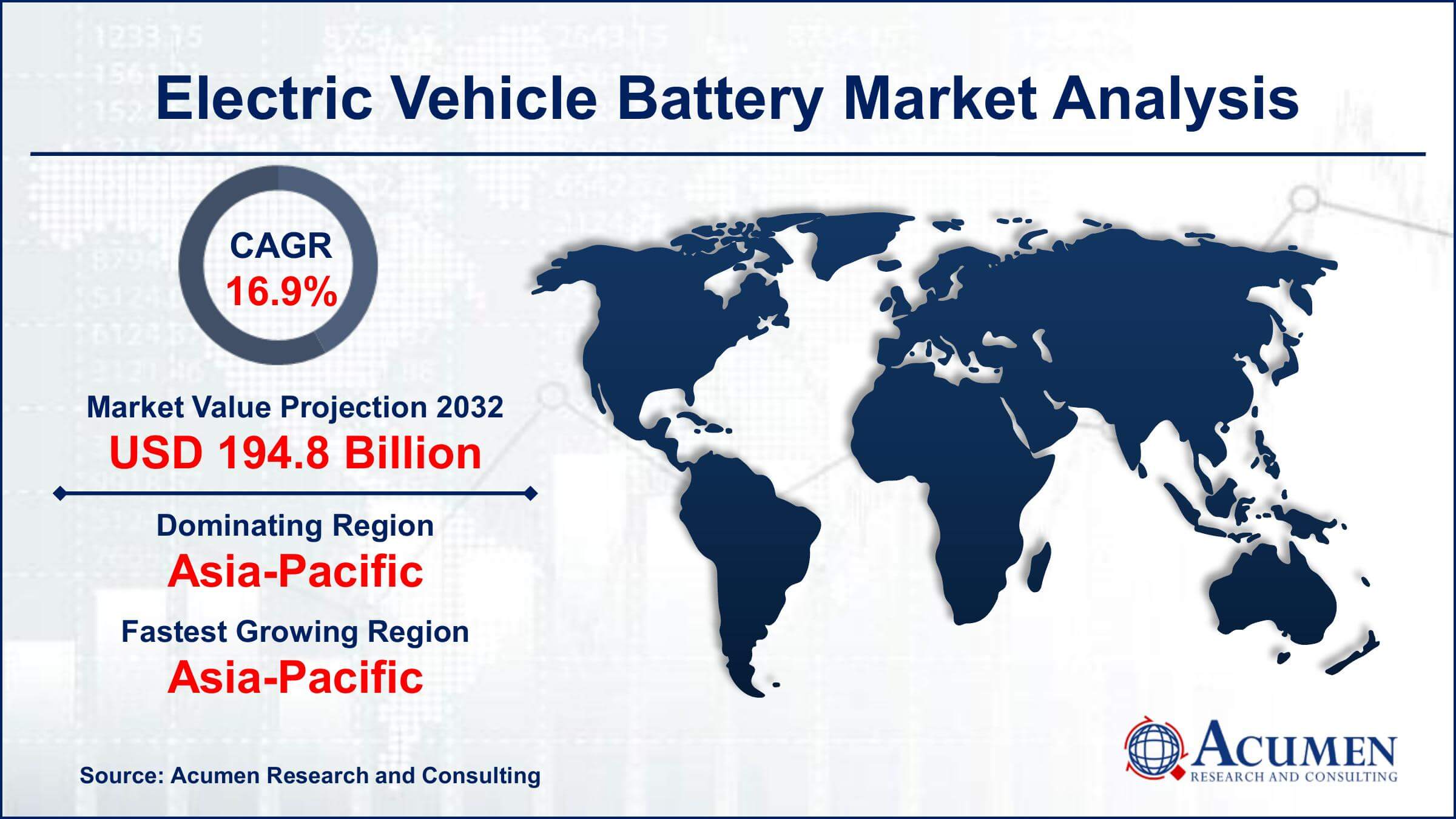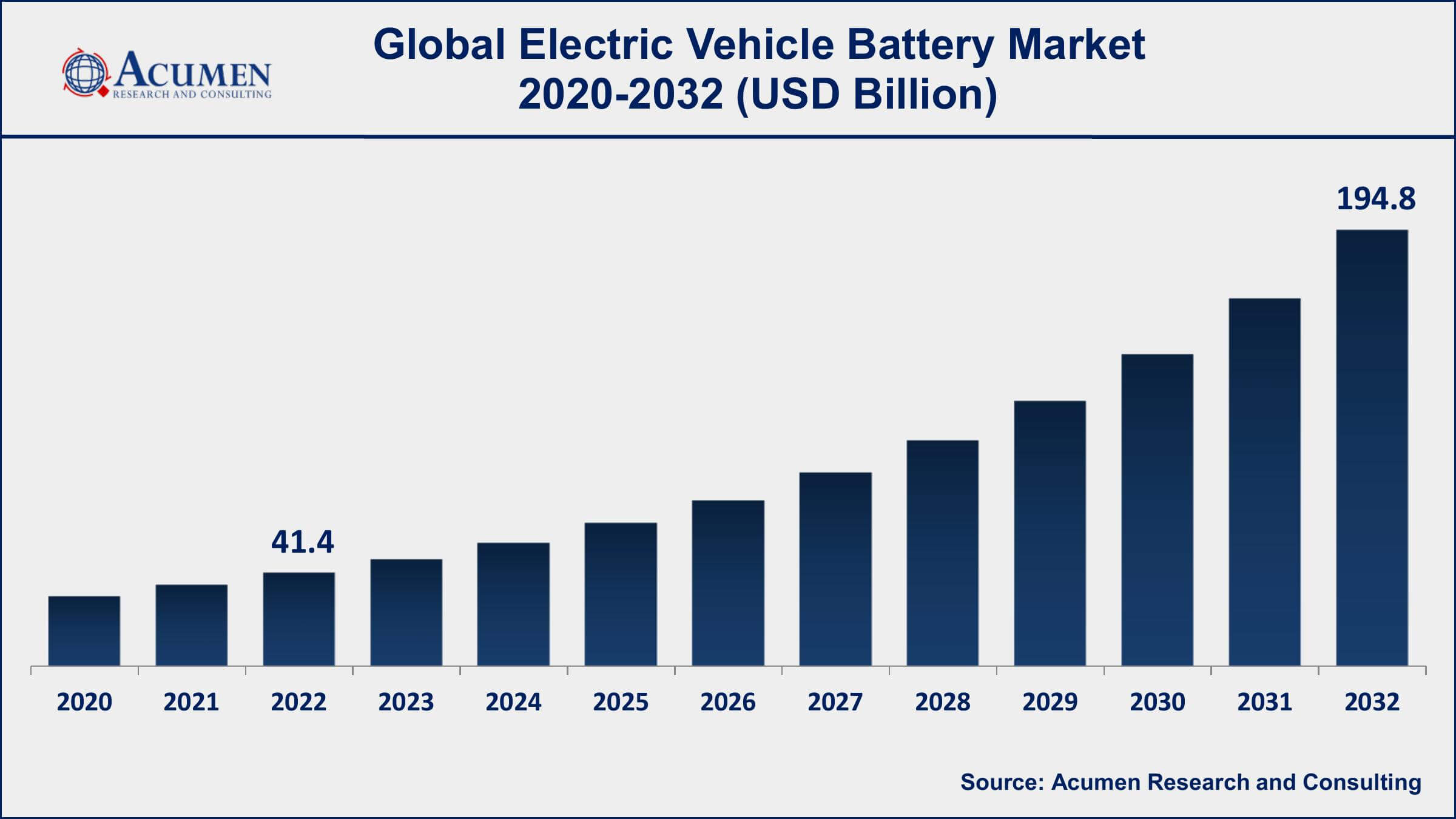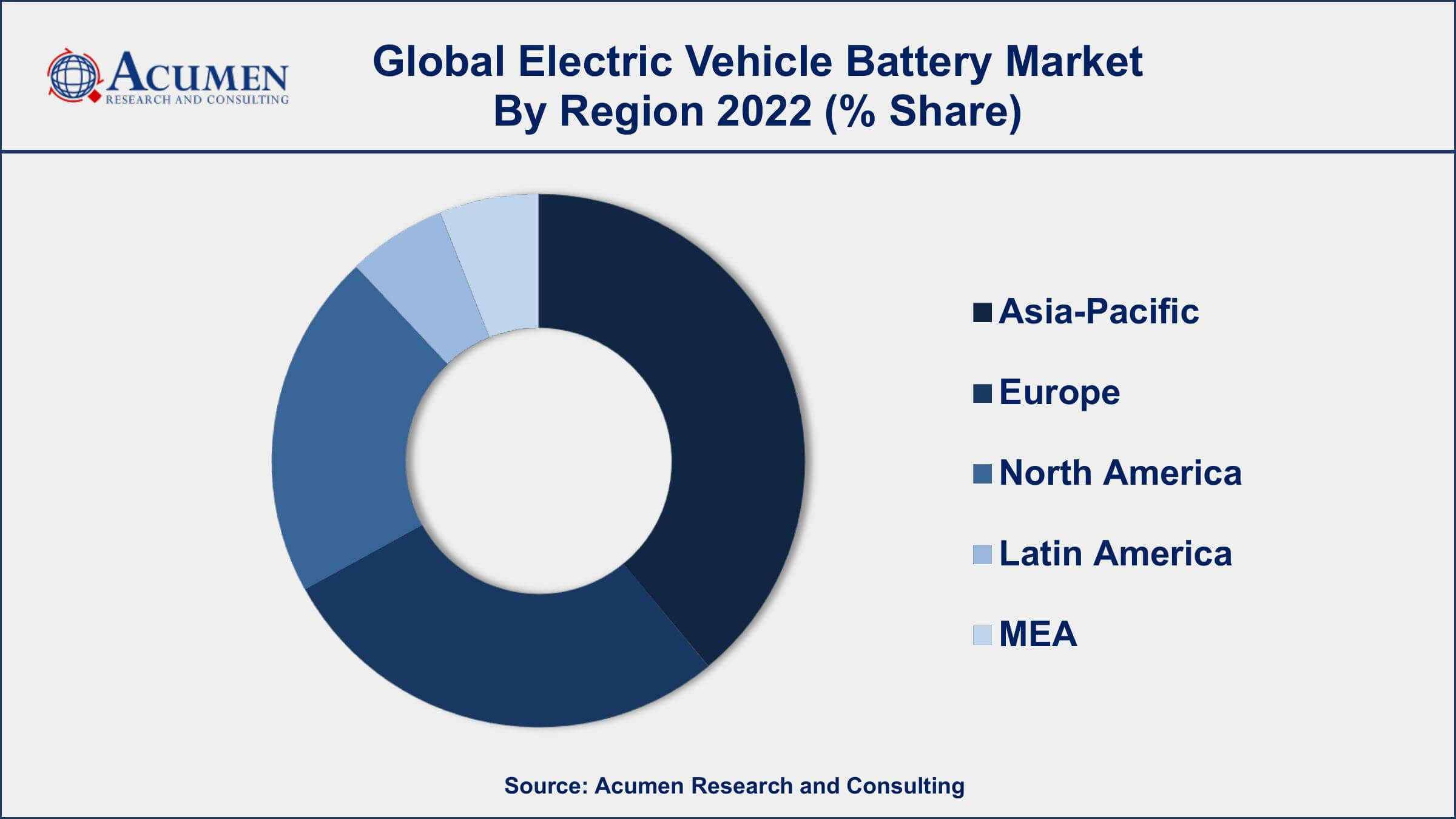May 2021
Electric Vehicle Battery Market Size accounted for USD 41.4 Billion in 2022 and is projected to achieve a market size of USD 194.8 Billion by 2032 growing at a CAGR of 16.9% from 2023 to 2032.
The Global Electric Vehicle Battery Market Size accounted for USD 41.4 Billion in 2022 and is projected to achieve a market size of USD 194.8 Billion by 2032 growing at a CAGR of 16.9% from 2023 to 2032.
Electric Vehicle Battery Market Highlights

An electric vehicle (EV) battery is a rechargeable battery that provides the primary power source for electric vehicles. These batteries are specifically designed to store and release electrical energy efficiently to power the vehicle's electric motor. The most common type of battery used in electric vehicles is the lithium-ion battery, which offers a high energy density and long cycle life.
The market growth of electric vehicle batteries has been remarkable in recent years. The increasing demand for electric vehicles, driven by environmental concerns and government policies promoting sustainable transportation, has been a key factor in the market's expansion. The advancements in battery technology, resulting in improved energy storage capacity, faster charging times, and longer driving ranges, have also contributed to the growing popularity of electric vehicles. Additionally, the decreasing costs of battery production and the establishment of a robust charging infrastructure have further accelerated the market growth. As more automakers invest in electric vehicle development and introduce new models with enhanced battery performance, the market for electric vehicle batteries is expected to continue its upward trajectory.

Global Electric Vehicle Battery Market Trends
Market Drivers
Market Restraints
Market Opportunities
Electric Vehicle Battery Market Report Coverage
| Market | Electric Vehicle Battery Market |
| Electric Vehicle Battery Market Size 2022 | USD 41.4 Billion |
| Electric Vehicle Battery Market Forecast 2032 | USD 194.8 Billion |
| Electric Vehicle Battery Market CAGR During 2023 - 2032 | 16.9% |
| Electric Vehicle Battery Market Analysis Period | 2020 - 2032 |
| Electric Vehicle Battery Market Base Year | 2022 |
| Electric Vehicle Battery Market Forecast Data | 2023 - 2032 |
| Segments Covered | By Battery Type, By Vehicle Type, And By Geography |
| Regional Scope | North America, Europe, Asia Pacific, Latin America, and Middle East & Africa |
| Key Companies Profiled | Tesla Inc., Panasonic Corporation, BYD Company Limited, LG Chem Ltd., Contemporary Amperex Technology Co. Limited (CATL), Samsung SDI Co., Ltd., A123 Systems LLC, SK Innovation Co., Ltd., GS Yuasa Corporation, Toshiba Corporation, Hitachi Chemical Co., Ltd., and Johnson Controls International PLC |
| Report Coverage |
Market Trends, Drivers, Restraints, Competitive Analysis, Player Profiling, Covid-19 Analysis, Regulation Analysis |
An electric vehicle (EV) battery is a rechargeable battery used as the primary energy storage device in electric vehicles. These batteries are specifically designed to provide the necessary power to propel the vehicle by supplying electricity to the electric motor. The most common type of battery used in electric vehicles is the lithium-ion battery, which offers a high energy density and can be recharged multiple times.
The applications of electric vehicle batteries extend beyond simply powering the vehicle. They play a crucial role in enabling various features and functionalities of electric vehicles. Apart from propelling the vehicle, electric vehicle batteries are utilized for powering auxiliary systems such as lighting, climate control, infotainment, and safety systems. The battery also serves as a source of power for regenerative braking, where energy is captured during braking and stored in the battery for later use. Moreover, electric vehicle batteries can be used for vehicle-to-grid (V2G) applications, allowing the battery to discharge electricity back to the grid during peak demand periods or in emergency situations.
The electric vehicle battery market has witnessed significant growth in recent years and is expected to continue expanding at a rapid pace. Several factors contribute to this growth. Firstly, the increasing adoption of electric vehicles worldwide is a major driver. Governments across the globe are implementing stricter emission standards and promoting electric vehicle adoption through incentives, subsidies, and tax benefits. This, coupled with rising consumer awareness of the environmental impact of traditional vehicles, has led to a surge in demand for electric vehicles, thereby driving the electric vehicle battery market growth. Moreover, advancements in battery technology have played a crucial role in the market's growth.
Electric Vehicle Battery Market Segmentation
The global electric vehicle battery market segmentation is based on battery type, vehicle type, and geography.
Electric Vehicle Battery Market By Battery Type
In terms of battery types, the lithium-ion segment has seen significant growth in recent years. Lithium-ion batteries have become the dominant technology for powering electric vehicles due to their high energy density, longer cycle life, and superior performance compared to other battery types. One of the key factors driving the growth of the lithium-ion segment is the continuous advancement in lithium-ion battery technology. Manufacturers are investing heavily in research and development to improve the energy density of lithium-ion batteries, allowing for longer driving ranges and improved overall performance of electric vehicles. These advancements have significantly contributed to the growing adoption of electric vehicles, consequently driving the demand for lithium-ion batteries. Moreover, the decreasing cost of lithium-ion batteries has played a pivotal role in their market growth. Over the years, there has been a decline in the cost of lithium-ion batteries due to economies of scale, technological advancements, and increased production capacity.
Electric Vehicle Battery Market By Vehicle Type
According to the electric vehicle battery market forecast, the battery electric vehicles (BEVs) segment is expected to witness significant growth in the coming years. BEVs, also known as all-electric vehicles, rely solely on electric power stored in batteries for propulsion, making the battery technology crucial to their performance and adoption. One of the primary drivers of the BEV segment's growth is the increasing demand for sustainable and zero-emission transportation. Governments worldwide are implementing stringent regulations and incentives to reduce carbon emissions and combat climate change. BEVs, with their zero tailpipe emissions, are at the forefront of this shift towards clean mobility. As a result, there has been a surge in consumer interest and adoption of BEVs, driving the demand for electric vehicle batteries specifically designed for these vehicles. Additionally, advancements in battery technology have significantly contributed to the growth of the BEV segment. Lithium-ion batteries, with their high energy density, have become the preferred choice for powering BEVs.
Electric Vehicle Battery Market Regional Outlook
North America
Europe
Asia-Pacific
Latin America
The Middle East & Africa

Electric Vehicle Battery Market Regional Analysis
Asia-Pacific has emerged as the dominating region in the electric vehicle battery market for several reasons. The Asia-Pacific is home to some of the largest electric vehicle manufacturers, including China, Japan, and South Korea. These countries have made substantial investments in electric vehicle production, creating a favorable ecosystem for the development and deployment of electric vehicle batteries. The presence of established automotive manufacturing infrastructure and expertise in battery technology has positioned Asia-Pacific as a key player in the electric vehicle battery market. Moreover, Asia-Pacific has a large consumer market for electric vehicles. The region's growing population, increasing urbanization, and rising disposable incomes have contributed to the high demand for electric vehicles. Additionally, the concerns over air pollution and the need for sustainable transportation solutions have resonated strongly in countries like China, leading to significant government support and incentives for electric vehicle adoption. This strong demand for electric vehicles has naturally fueled the growth of the electric vehicle battery market in the region. Furthermore, Asia-Pacific has also made significant investments in battery manufacturing capacity. China, in particular, has emerged as a global leader in battery production, with a significant share of the world's lithium-ion battery manufacturing capacity.
Electric Vehicle Battery Market Player
Some of the top electric vehicle battery market companies offered in the professional report include Tesla Inc., Panasonic Corporation, BYD Company Limited, LG Chem Ltd., Contemporary Amperex Technology Co. Limited (CATL), Samsung SDI Co., Ltd., A123 Systems LLC, SK Innovation Co., Ltd., GS Yuasa Corporation, Toshiba Corporation, Hitachi Chemical Co., Ltd., and Johnson Controls International PLC
Looking for discounts, bulk pricing, or custom solutions? Contact us today at sales@acumenresearchandconsulting.com
May 2021
July 2021
April 2020
July 2020